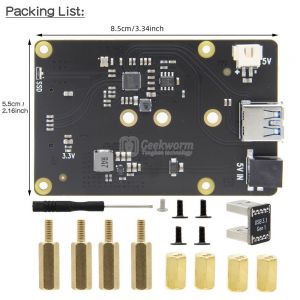X862 V1.0
Contents
Overview
X862 has been upgraded to V2.0 version, please refer to X862 V2.0
X862 is M.2 NGFF SATA SSD Shield for Raspberry Pi 4 model B. It provides a complete storage solution for raspberry pi 4. Now there are 2 versions of X862.
X862 V2.0 ONLY support M.2 NGFF SSD Key-B 2280 length.
X862 V1.0 supports multiple M.2 NGFF SSD lengths including: 2280, 2260, 2242, 2230.
Important NOTE:
- The case of X862 V1.0 and X862 V2.0 are different. X862 V1.0 should use X857-C1 Case, but X862 V2.0 use X857-C3 Case.
- X862 V1.0 version supports TRIM but not UASP, V2.0 version supports UASP but not TRIM.
- After our test, X862 V2.0 can connect to 2.4G wifi in seconds without the metal case. However, if X862 work with a metal case or external USB 3.0 devices such as a mouse or keyboard, you may still need to use Ethernet or 5G AP.
- This X862 is not fit to ROCK64 and Raspberry Pi 3B+ /3B because the difference of USB 3 position. Please refer to X860 if you want use M.2 NGFF SATA SSD on the Raspberry Pi 3B+/3B or ROCK64 board.
Features
| FOR USE WITH |
Raspberry Pi 4 Model B |
| Operating System |
All Raspberry Pi operating systems |
| KEY FEATURES |
|
| SPECIFICATION |
|
| NOTES |
|
How to Power
Packing List
- X862 V1.0 M.2 NGFF SATA SSD Shield x 1
- USB3.1 jumper x 1
- Screw M2.5 *6mm x 4
- Spacer M/F M2.5 *12mm x 4
- Spacer F/F M2.5 *8mm x 4
- Screw driver x 1
- Screw M2 *4mm x 1
Matching Metal Case
Please refer to X857-C1 Case
Installation video for Raspberry Pi 4+ X862 V1.0 + X735 + X857-C1 Case: https://youtu.be/TrQwcPBU9S0
User Manual
- About USB boot please refer to Does the X825/X855 support USB boot
- File:Usb3-frequency-interference-papers.pdf
- https://raspberrytips.com/format-mount-usb-drive/
Customer video for your reference: https://youtu.be/Q1btyPoL0GI
- USB boot video for reference:
FAQ
Q1: What to do if you find the SSD is not recognize?
A: 1. Please confirm that you use the SSD with right interface which match with the socket of your expansion shield. (Not recommend to use SAMSUNG SSD, as there will be big EMC interference.)
2. If use WiFi, please try to close WIFI to test.
3. Please use right interface M.2 SATA SSD (KEY-B) to X862.
4. Please try provide extra power to X862.
5. Please test and make sure your Raspberry Pi4 USB3 port is good one. (We get the feedback that Pi 4 USB3 port is easy to broken)
If still any issue, please email us at support@geekworm.com and provide the follow information:
- 1. Your order number.
- 2. The SSD model you use.
- 3. Photos about all the hardware connection.
- 4. Run the command " lsusb" and show us the result.
Q2: What to do if you find the 2.4G Wi-Fi is not stable when use Raspberry Pi 4 with expansion board(like X825/X857/X862/X872) connected by USB3 connector?
A: 1.Please try to use WIFI 5G AP if you find the 2.4G signal is unstable, because we found that USB 3.0 high-speed transmission will interfere with the Raspberry Pi's 2.4G wifi signal. We think this is caused by the unreliability of the Raspberry Pi's wifi design. If the Raspberry Pi Foundation reserves the SMA IPEX antenna interface, everything will become easier. please refer to https://www.raspberrypiwiki.com/images/5/53/Usb3-frequency-interference-papers.pdf
2. You can also use a USB wifi dongle to connect to Pi's USB2.0 to solve the problem.
Q3. Does it support booting from SSD?
A: Yes. A microSD card is required for forcing the Raspbian OS to use the HDD/SSD for its "root" partition. Please refer to How to Run Raspberry Pi 4 or 3 Off an SSD or Flash Drive or Please refer to Does the X825/X855 support USB boot
Q4: How to Initialize, Partition and Format a Brand New SSD in Windows
A: Please refer to Tutorial Initalize New SSD
Q5: About the X862 write speed
A: According to the test, the X862 can reach about 300mb/s write speed, but you need to install the Raspberry Pi OS into the SSD then test the speed.(Note: the copy date speed is not accurate.)
Q5: Does the X862 support UASP or TRIM?
A: X862 has two versions, V1.0 version supports TRIM but not UASP, V2.0 version supports UASP but not TRIM.
Q6: How to test the access speed of Raspberry Pi?
A: Please refer to: https://jamesachambers.com/raspberry-pi-storage-benchmarks/ ; Please use the RASPBIAN to test.









Enable comment auto-refresher
Anonymous user #3
Permalink |
Walker
Anonymous user #3
Permalink |
Anonymous user #3
Anonymous user #1
Permalink |
Cindy
Anonymous user #2